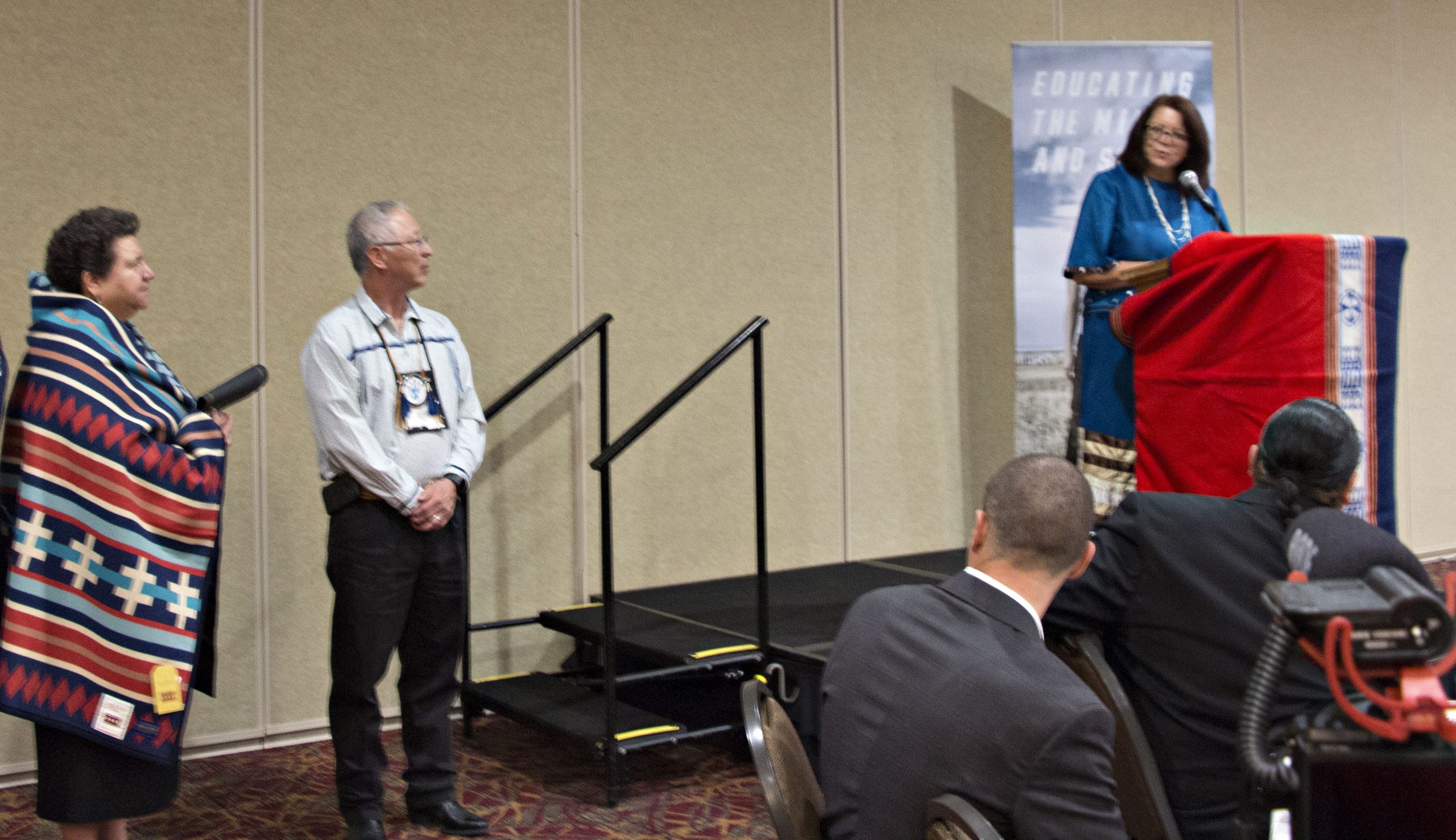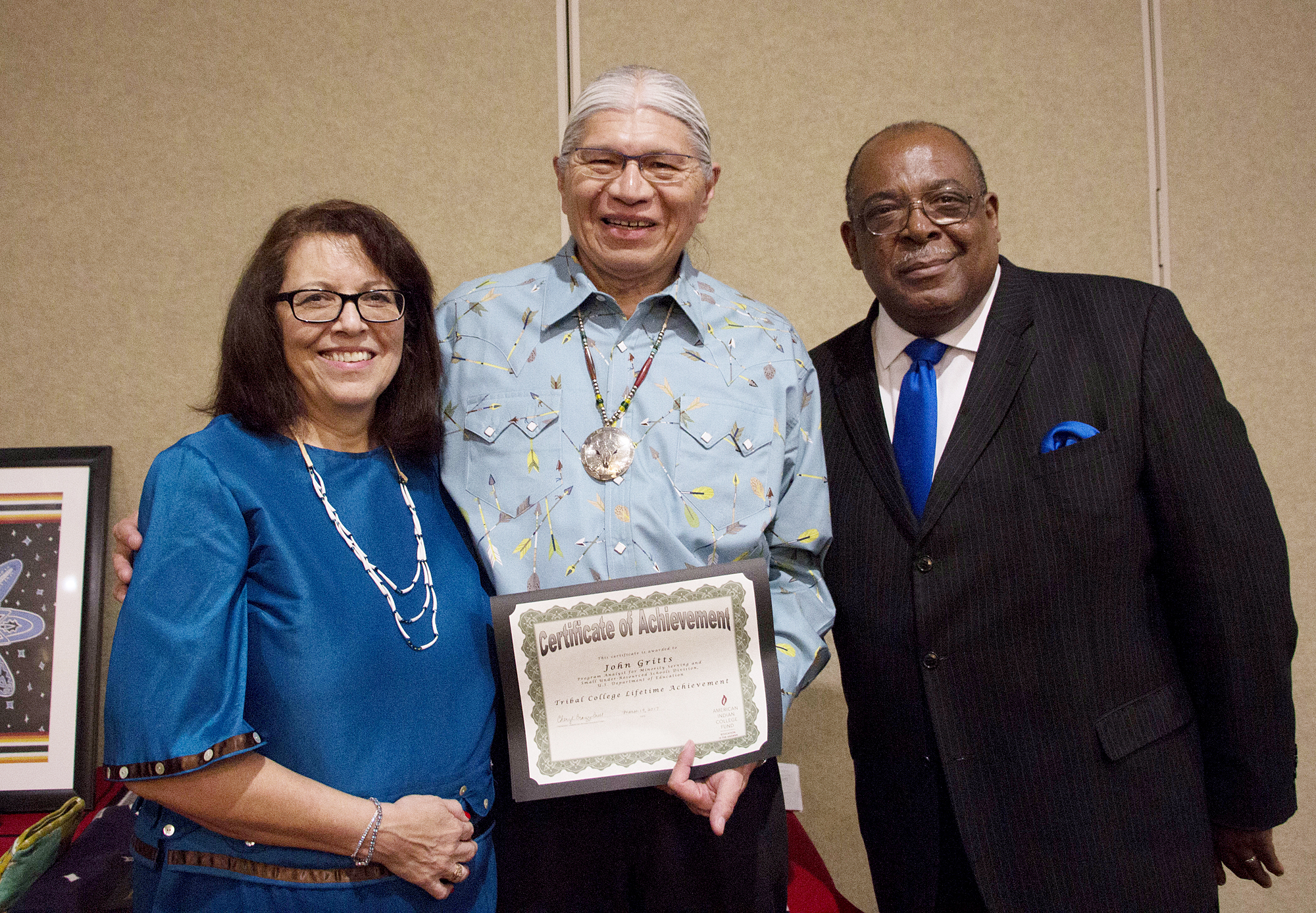Dr. Laurel Vermillion named 2017 American Indian College Fund TCU Honoree of the Year
John Gritts 2017 Lifetime Achievement Award

Laurel Vermillion, President of Sitting Bull College.
Dr. Laurel Vermillion
The College Fund named Dr. Laurel Vermillion, President of Sitting Bull College in Fort Yates, North Dakota and a member of the Standing Rock Sioux Nation, the 2017 American Indian College Fund TCU Honoree of the Year. This honor recognizes a distinguished individual who has made a positive and lasting impact on the tribal college movement.
Dr. Vermillion was chosen for her leadership in expanding opportunities in workforce education, business, and environmental science through developing an exemplary relationship with the Standing Rock Sioux Tribe, allowing Sitting Bull College to lead and collaborate with all educational entities on the reservation, in addition to her support of Lakota language education within her community and throughout the Lakota Nation.
Dr. Vermillion was recognized March 19 during the 2017 Coca-Cola Scholars and Student of the Year Awards Banquet in Rapid City, South Dakota in conjunction with the American Indian Higher Education Consortium Spring Student Conference. She was wrapped with a Pendleton blanket and presented with a $1,200 honorarium provided by the Adolph Coors Foundation.

Laurel Vermillion, left, is wrapped in a Pendleton blanket at the American Indian College Fund Student of the Year, First-Generation Scholars Awards banquet in Rapid City, S.D.
Dr. Vermillion spoke to the College Fund about her career path that led her to her role as President of Sitting Bull College, located on the Standing Rock Reservation which is near the Dakota Access Pipeline (DAPL) site.
“I am very honored to have this award,” Dr. Vermillion says. Because of DAPL she has been thinking about the importance of water to her personally, her community, and the state.
“Ever since I was a child I have known the importance of water to my tribe and community. We lived 1.5 miles away from the Missouri River, and my family hauled water from it. I remember going with my grandparents by horse-drawn wagon to the river to haul water back to their ranch. I remember it like it was yesterday. As we got close to the river, we went through a forest of trees, and I remember how cool it was in there and the smell…then on the other side of the trees we would get closer to the riverbank. There my grandfather would back his team into the water as far as he could, fill the barrels, and cover them with a tarp so the water would not splash out. On the way home we always stopped in the trees and picked wild grapes. My grandmother brought buckets and we filled them with grapes until our hands were purple. At home she would make jellies with them.”
“Since the damming of the river in the 1960s, those trees are not there anymore. It hurts me to have those memories of all those trees and know that those trees, fruits, and animals are no longer there. The 1806 River Road to Bismarck still has a lot of those trees we had. Here on the reservation we lost all of our trees since the flooding of the land. Those trees and that land were important and used in ceremony and it is no longer there. I guess these are my fondest memories because I can remember it so clearly,” she says.
Growing up so near a river, it is not surprising that Dr. Vermillion’s education and career path resembles in so many ways a river’s journey.
Dr. Vermillion grew up in a rural area, and “when I was a girl I walked two miles to county school, which was a one-room school with around 25-30 students of all ages and grades. My county school experience laid the foundation for me to love books and learning but to also want to be a teacher,” she says. She recalls her teacher, Hope Chamberlain, saying she was “a wonderful teacher. From my first year on, school was a wonderful experience. She taught government, how to care for our flag, music, how to sing the Star Spangled Banner and many other songs, and the class was like a family. We learned to be independent and assume responsibility.” Students took turns doing chores, cleaning the floors and outhouse, hauling water to the school room from the pump, and watering plants.
“The older kids were your mentors. There were no assistants. And when we grew older, we go to be the mentors. We were taught a lot of responsibility and learned to work as a team,” she says.
Although she didn’t know it at the time, Dr. Vermillion was getting an education in how to teach. “A lot of the things our teacher did I took on as a teacher myself. For example, she loved books and I learned from her how important it is to read to your kids. Every day before class started she would read a book, and would stop in a place where we were anxious for her to continue. Right before recess she would pick up and read again and right before we went home. All ages enjoy having someone read to them. It sparked my interested in teaching.” When Dr. Vermillion went on to teach elementary school, she remembered that and read to her class as well.
Yet there was a bend in her journey at first. Despite the early indications that seemed to point her towards an education career, Dr. Vermillion says her dream in high school was to be a secretary. After graduating in 1973 she worked with the Standing Rock Housing Corporation, but discovered spending days with a Dictaphone transcribing was not stimulating enough for “a people person.” After she married in October 1973 Dr. Vermillion found a job as a teacher’s aide in the Head Start program, and she knew she had found her life’s calling. “I just loved it. I loved teaching, I loved the children, and I loved all of it.”
It was there that she met a man who would change her career forever. Dr. Jack Barden worked with many tribal colleges writing grants. He told her a tribal college was starting on her reservation and invited her to take classes. “Before then no one had talked to me about going to college. He lit my fire about getting a higher education. I started classes in the evenings. Back then there was not a building, so we met at the Douglas Sky Memorial Complex. We had to look for a place each day to sit and have class. There were about four or five students. Sometimes we met in a vacant room or a hallway. It was very fun and interesting,” she says.
Long after Sitting Bull College was officially launched, Dr. Barden continued to play a role in the college’s leadership as well as a mentor to Dr. Vermillion. “Neither of my parents graduated from high school. I came from a ranching family and they were busy with ranching. My Mom was excited and supportive when she heard I wanted to go to college, but college was foreign to her. I learned to navigate on my own with the help of Dr. Barden,” she says.
After completing general education requirements at Sitting Bull College, Dr. Vermillion learned that Standing Rock Community College and University of North Dakota (UND) through a grant were offering a teacher education program to train Native students from the Standing Rock Reservation to be teachers. She jumped at the opportunity to continue her education with 18 students in the cohort while still working as a teacher’s aide. She graduated with a bachelor’s degree in 1980 and began teaching at Fort Yates Elementary School that same year.

Dr. Laurel Vermillion, President of Sitting Bull College, attends the HERS program at the University of Denver for professional development through the Lilly-sponsored Woksape Oyate Wisdom of the People grant.
For 13 years Dr. Vermillion taught full-time while also earning her master’s degree at UND through a program called Project IDEAL (Indians Developing as Education Administration Leaders). The program also used the cohort model, which she says is a great model for Native students who place a great value on familial and community relationships. “You become tight-knit, like a family, and rely on the strengths of other students.” In addition to giving members of her cohort the opportunity to visit each other’s reservations, the program allowed her to develop lifelong personal and professional relationships with other educators.
After completing her master’s degree in 1994, Dr. Vermillion was offered a position as the elementary/middle school principal for Marty Indian School, which served children from kindergarten through eighth grade. It was especially touching for her, she says, as her parents had attended that school.
The first month of her job there was no housing available nearby, so Dr. Vermillion was invited to stay with several nuns who lived down the street from the school. One of the sisters was a relative of her mother’s. The job was a busy and emotionally demanding one, she says, with many students there by court order or with discipline problems. She worked long days and savored walking home after work, transitioning to the peace of her living situation, where the women took turns cooking before evening quiet time. “I needed that time. I believe we find what we need when we need it. Those things happen for a reason,” she says.
After her first year in Marty, Dr. Vermillion’s career journey took an unexpected turn. “I got a call from Linda Comeau, Vice President of Academics at Sitting Bull College, asking me, ‘Do you want to come home?’ She was taking a leave of absence to get a doctorate degree. I had been in Marty by myself; my husband had stayed at Standing Rock to work and I did want to get back. I applied for the position and started in July of 1995 as the Vice President of Academics. It was very different from elementary education.”
Despite the differences between higher and elementary education, Dr. Vermillion’s enthusiasm paved the way for success. She threw herself into constantly learning and was promoted to the position of Vice President of Operations in 1999. During that time she decided to get her doctorate degree when she heard her alma mater, UND, was bringing classes to Bismarck, using the cohort model that she had enjoyed both as an undergraduate and graduate student. She began the process in 2000 and in 2005 was awarded her Ph.D. in Higher Education, Teaching and Learning.
In 2005 when then-president Ron His Horse Is Thunder ran for election for tribal chairman and won, Dr. Vermillion was appointed to the post of interim president at Sitting Bull College. Her appointment became permanent in spring of 2006.
Dr. Vermillion says, “When I talk with students and share my experiences, I tell them ‘Sometimes doors open and you just have to take that step. If you wait, the door closes and you don’t have that opportunity again. You have to surround yourself with people that can help you make those decisions about whether or not to pursue something.’” She credits Dr. Barden with being that mentor for her during her educational journey.
Whether in a one-room school to elementary school or a tribal college, one thing has remained constant in Dr. Vermillion’s career path—her love of teaching and watching young people succeed. “TCUs are so successful because we take time to encourage and help students. You’d be surprised at how good that makes them feel,” she says.
John Gritts

John Gritts (right) and his wife Page pose for a photo in Denver, Colo.
John Gritts, a management and program analyst, Federal Student Aid department, U.S. Department of Education, was awarded the American Indian College Fund’s first Lifetime Achievement Award. The award is in recognition of his ongoing service in supporting and furthering the missions of tribal colleges and universities throughout his career.
In honor of Mr. Gritts’s dedicated service, the Adolph Coors Foundation is providing a $1,200 donation in memory of his son, Trevour Joe Gritts, to the Salish Kootenai College Foundation. He was recognized March 19 at the 2017 Coca-Cola Scholars and Student of the Year Awards Banquet in Rapid City, South Dakota in conjunction with the American Indian Higher Education Consortium Spring Student Conference.
Gritts said, “When I learned about the award, I was totally shocked. When you work, doing your job, you are not looking for these things. When you learn about tribal colleges and universities, you can always be an advocate.”
“Having started my career at Black Hills State in the student services and financial aid field, you can’t help but know or see what student need is.” At the time, he says Sinte Gleska University and Oglala Lakota College, both tribal colleges in South Dakota, had not yet earned their accreditation, so he also worked with them, traveling to their campuses to provide financial aid services.
“The schools were so welcoming. I knew people at Rosebud Reservation but not at Pine Ridge Reservation, and it was fun to meet new people and be part of that process. Gritts was an associate at Black Hills State for six years before he was promoted to the Director of Financial Aid position there in 1980.
Gritts has accumulated many stories throughout his career, but one that comes to mind was of a rancher who visited him about financial aid for his daughter. Gritts explained the process and said he looked forward to her being a student at Black Hills State.
“Oh, she’s not going here. She’s going to South Dakota State,” Gritts recounted. “I told him he should have spoken with the officer there, but he said he was told to talk to me because I would explain it better.”

American Indian College Fund President and CEO, Cheryl Crazy Bull presents the College Fund 2017 Lifetime Achievement Award to John Gritts (center) in Rapid City, S.D., on Sunday, March 19, 2017
Gritts moved to Denver in 1997, where he continued his work with tribal colleges in an official capacity with the American Indian College Fund for nine years. Those were the early days of the College Fund, and he remembers sharing a cramped office with many staffers, one phone line, and one e-mail account and taking turns. “We were always breaking circuits,” he laughs.
But in that close environment “You can’t help but learn. I will never forget our first gala—how touching it was to hear our students’ stories when they spoke. And it is great seeing the light come on with our students, whether they are young or middle-aged or old, and decide they need an education. The best time, of course, is graduation, whether it was at Black Hills State or at a TCU. When the students walk across the stage and then say thank you; that is all it takes. You cry like a baby,” Gritts says.
After leaving the College Fund, Gritts joined the staff at his alma mater, IAIA, where he studied painting, before accepting a position with the U.S. Department of Education.
He says he enjoys his current job because he is trouble-shooting, helping the tribal colleges and universities with problems with their reports, audits, and deadlines. He also focuses on relationships and communications and as a result, is well-known and beloved. When he was traveling for a tour of Salish Kootenai College in Montana with then-U.S. Secretary of Education Arne Duncan, “I went up and introduced myself, and he said, ‘Yes, I know who you are.’”
As he readies for retirement, Gritts says, “It was and isn’t a job. It’s doing what you like.”






